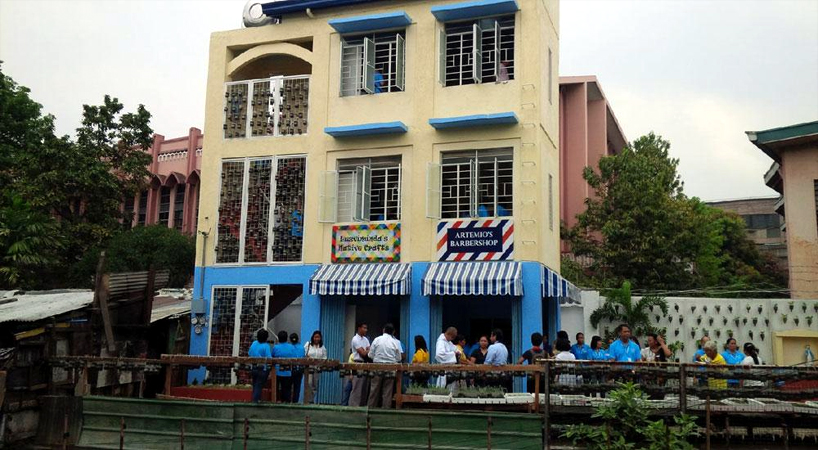Energy-efficient, disaster-resilient homes for urban poor unveiled
MANILA, Philippines – Along Estero de San Miguel in Sampaloc, Manila looms a three-story building.
Painted blue and beige, the structure features two fictional enterprises: a barbershop and a crafts store on the first floor. Above it are two residential units with windows wide open. A third of the building is devoted to the staircase, seen from afar through metal screens where small plants are hung.
It is what the government calls the Estero de San Miguel medium-rise building (MRB) model unit.
Occupying a 24 square meter lot, the structure is supposed to house two families – one in each floor, with the first floor serving as “flood buffer.”
It is a model unit not only of the so-called innovative “micro-MRBs” but also of the government’s in-city resettlement program, an alternative to the decades-old practice of banishing informal settlers to provinces outside Metro Manila.
“Mula sa dating kalakaran na ipinagtatabuyan ang mga kapus-palad nating mamamayan bilang solusyon sa siksikan at pagkasira ng mga lungsod, inilalatag natin ang mga makabuluhang programa na nagbibigay-lakas at pagkakataon sa mga nasa laylayan ng lipunan,” President Benigno Aquino III said Wednesday during the unveiling of the model unit.
(From our old practice of evicting impoverished citizens to solve the congestion and deterioration of cities, we are now presenting a significant program that would give strength and opportunities to marginalized sectors.)
Aquino said 167 informal settler families will be awarded with similar shelters along the waterways.
He said the new building scheme supported the government’s efforts to provide residents with safe homes, clean waterways and long-term solutions against community.
Green architecture
The micro-MRB, which fits into the narrow lots outside the 3-meter easement along esteros, was conceptualized by architect Felino Palafox and implemented by architect Albert Zambrano of the Mapua Institute of Technology, School of Architecture.
Zambrano said the buildings are considered “affordable shelters” as opposed to “low-cost housing,” which tries to push down the cost of construction by using cheaper materials.
The MRBs, while more costly, are built to withstand floods and earthquakes. In case water rises overnight, the residents will be safe on the second and third floors.
It also promotes a cheaper lifestyle since its residents won’t need to spend that much for transportation. It is also near commercial establishment that can be reached by walking or riding a bike.
As an “energy-efficient” building, it utilizes natural light and ventilation, keeping electricity costs down.
It also has a rain water harvesting system and a pest or vermin-resistant design.
Zambrano said the building was durable and would not be easily destroyed in 30 years or even 100 years.
The architect also boasted of the program’s livelihood component. The first floor of the building can easily be converted into small stores so the residents can earn a living.
In a separate interview with Inquirer, Filomena Cinco, president of Nagkakaisang Mamamayan sa Legarda, under their agreement with the government, the monthly amortization will be based on the beneficiaries’ capacity to pay. Some can pay P300 a month, others P500 or P1,000.
Jesse Robredo’s vision
During the event, residents of Barangay (village) Sampaloc, Manila thanked the late Interior Secretary Jesse Robredo for his support.
“Sa yumaon Secretary Jesse Robredo, mabalos! (To the late Secretary Jesse Robredo, thank you!)”Cinco said.
The residents credited Robredo for listening to their concerns and helping them push through with the project.
It was revealed that the Estero de San Miguel project was created through a “people’s plan,” with the residents themselves working with the government to find architects and funding for the program.
Aquino said it was Robredo who had a “vision.”
“Siya rin ang nagpakita ng nagawa niya sa Naga, at siya rin ang naglakas-loob na noong panahon na puro problema ang inaani ng inyong pamahalaan eh nagsabing, ‘Masosolusyunan natin ito. Kailangang lang natin P50 billion.’ Sabi ko, ‘Jess, ang dami namang zero ang kailangan mo,’” the President said in jest.
(He was the one who showed what had already been done in Naga, and he was the one who had the courage to say during troubling times for the administration, ‘We can solve this. We just need P50 billion.’ I said, ‘Jess, that’s a lot of zeros you need.’)
Setbacks
However, Aquino admitted that the in-city resettlement plan faces many challenges.
In addition to the funds needed and the long and tedious process each project will go through, the purchase of available land is also a cause of worry.
The President said every time he went around the country, he keeps looking for possible sites for micro-MRBs. Unfortunately, he said there are only a few.
But he said it was no reason not to try and act on the problems of the urban poor.
Aquino said P10 billion was already set aside to relocate families in danger areas. He said they are targeting the transfer of 11,000 families living near waterways by August this year.
RELATED STORY
Aquino inspects model unit of in-city relocation program















